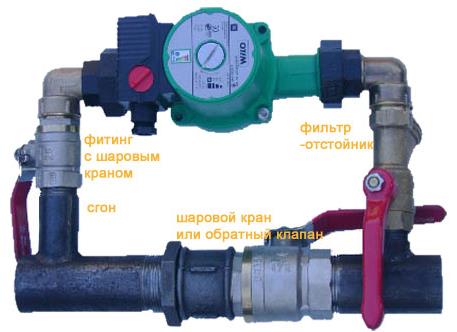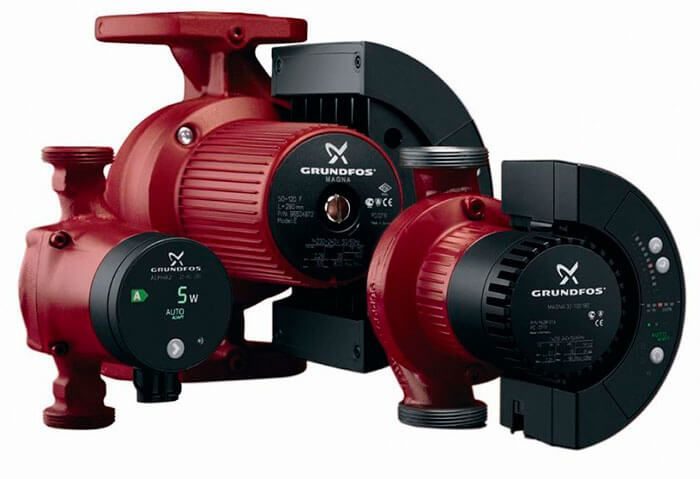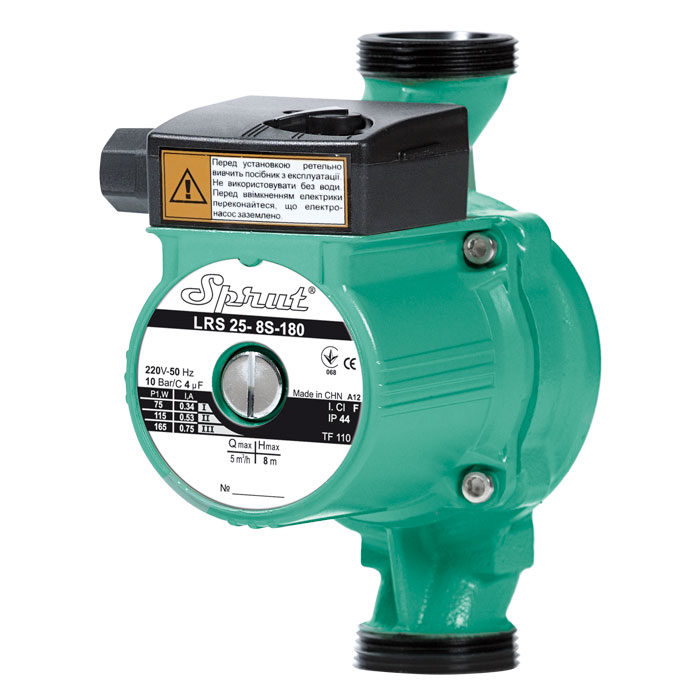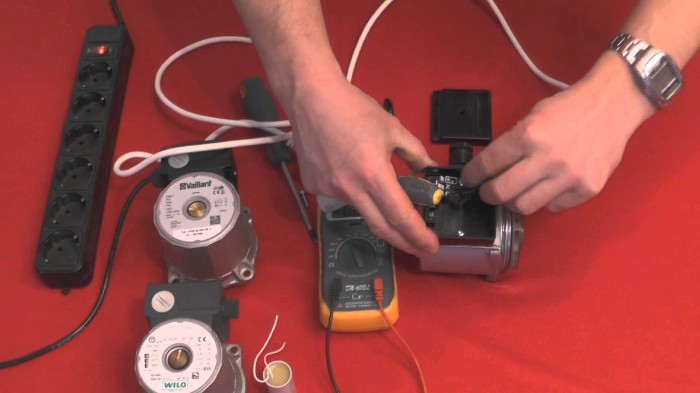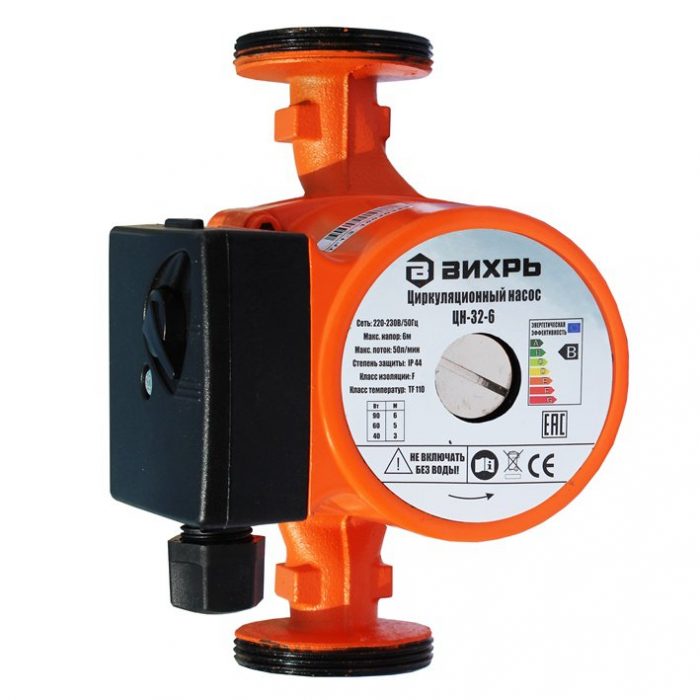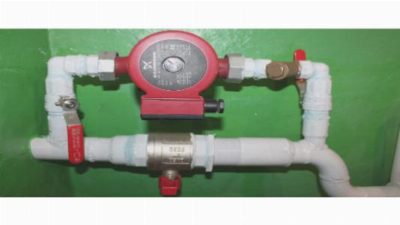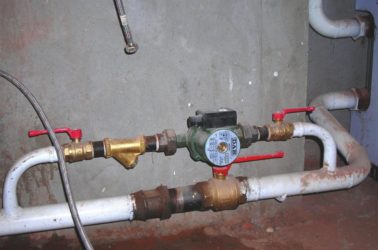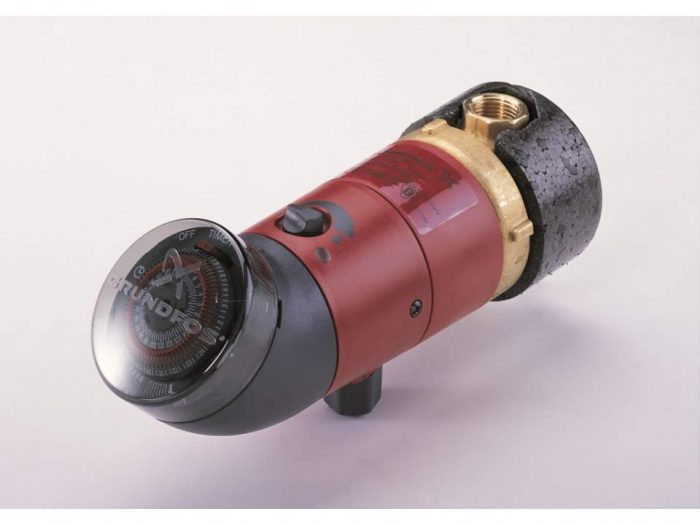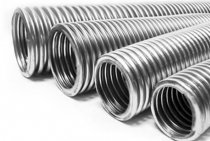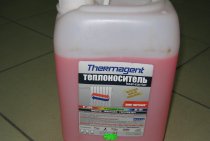How circulation pumps are arranged and work
The principle of operation of circulation pumps is not much different from the device of drainage models. The case of the device is made of durable materials resistant to corrosion. Usually it is stainless steel, aluminum, brass, cast iron. When starting, the engine begins to rotate the rotor equipped with an impeller. As a result, the pressure at the inlet pipe decreases and water is sucked into the hydraulic chamber. The rotation of the impeller creates centrifugal force. Water is pressed against the walls of the chamber and is forced out into the pipeline through the outlet. This ensures forced circulation of the coolant in a closed heating circuit.
Design differences between devices of different types
There are two main types of pumps - with "wet" and "dry" rotors. The "wet" rotor is separated from the water by special sealing rings, between which there is a thin water film. When worn, the rings wear out and are pressed against each other more tightly, which guarantees the tightness of the structure for several years. Cooling and lubrication are carried out by the working fluid. Pumping equipment of this type is installed in systems that are small in terms of coolant volume, because. it is difficult to ensure the tightness of joints in structures of large diameter
When mounting devices, it is important to achieve a strictly horizontal arrangement of the shaft, otherwise the device may malfunction
The main advantage of "dry" models is high efficiency. It is 80%, which compares favorably with the 50% efficiency of wet type devices. The rotors of "dry" heating circulation pumps do not come into contact with the liquid. Depending on the location of the engine, the structures are divided into horizontal (console), vertical and block. All "dry" models are noisy during operation, sensitive to the quality of the coolant and the purity of the air. It is advisable to install them in separate boiler rooms, controlling the purity of the water in the system and the air in the room.
a source
Why is the heating pump heating up
When installing a closed-type heating system, a circulation pump is installed on the pipeline. The main task of this device is considered to be the pumping of coolant, water or antifreeze, which ensures quick and uniform heating of all living quarters of a summer house, cottage or any other country house. Thanks to the pump and the automation of the boiler, the user can set the optimal temperature indicators in his home, but sometimes such a device overheats and cannot perform the assigned tasks with high quality. In our article, we will get acquainted with the causes of this phenomenon and methods for solving such a problem.
Possible breakdowns and ways to eliminate them
necessary to fix the problem. By the way, it is recommended to protect the pump from power surges by installing a reliable stabilizer. Such a move will also protect the pump from burning a fuse, which fails as a result of constant pressure drops in the network.
So, if, nevertheless, trouble happened to your circulation pump, and it refuses to work, then we will try to repair the unit with our own hands.
Important: but if you are not sure of your abilities or do not have the appropriate tool at hand, then it is better to contact a specialized center
If the pump makes a hum, but the impeller does not rotate
The reasons may be the following:
- The presence of a foreign object in the area of the impeller;
- The rotor shaft was oxidized due to a long idle time of the unit;
- Violation of the power supply to the terminals of the mechanism.
In the first case, you need to carefully remove the pump from the heating system and unwind the housing in the area of the impeller. If a foreign object is found, remove it and rotate the shaft by hand. When assembling the pump in the reverse order, it is necessary to install a reliable filter on the nozzle.
If de oxidation takes place, then it is well cleaned, all movable elements of the working unit are lubricated and the pump is assembled in the reverse order.
If the problem is in the quality of the power supply, then you will have to check the voltage with a tester. First, in all sections of the cable and if a break or malfunction is detected, completely replace the latter. Then, if the cable is in order, check the voltage at the terminals. If the tester shows infinity, a short circuit has occurred. If it shows less voltage, then the winding has broken. In both cases, the terminals are replaced.
If the unit shows no signs of life at all
This can happen if there is no voltage in the network. Using a tester, check the voltage and, if necessary, fix the problem.
By the way, it is recommended to protect the pump from power surges by installing a reliable stabilizer. Such a move will also protect the pump from burning a fuse, which fails as a result of constant pressure drops in the network.
If the pump starts but then stops
The reasons may be:
- The presence of scale between the moving elements of the unit;
- Incorrect connection of the pump near the terminals.
In the first case, you will have to disassemble the pump and check it for scale. If limescale is found, remove and lubricate all joints between the rotor and the stator.
If there is no scale, then check the tightness of the fuse on the unit. You should remove it and thoroughly clean all the clamps. Here it is worth checking the correct connection of all wires in the terminal box by phase.
If the pump makes a loud noise when turned on
The reason for this is the presence of air in the closed circuit. It is necessary to release all air masses from the pipes, and mount a special assembly in the upper part of the pipeline to prevent the formation of air pockets.
Another reason could be wear on the impeller bearing. In this case, you need to disassemble the body of the unit, check the bearing and, if necessary, replace it.
If the pump makes noise and vibrates
Most likely, the matter is in insufficient pressure in the system. It is necessary to add water to the pipes or increase the pressure in the area of the inlet pipe of the pump.
If pressure is still low
Here it is worth checking the direction of rotation of the working unit in the pump housing. If the wheel turns incorrectly, then a mistake was probably made when connecting the device to the terminals by phases in the case of a three-phase network.
Another reason for the decrease in pressure may be too high viscosity of the coolant. Here the impeller experiences a lot of resistance and does not cope with the tasks. You will have to check the condition of the strainer and clean it if necessary. It would also be useful to check the section of the pipes of the inlet and outlet and, if necessary, set the correct parameters for the operation of the pump.
Unit features
The principle of operation of circulation pumping equipment is based on the creation of continuous circulation of fluid in the system without changing the pressure indicator.
A circulation pump is a device that operates in a closed heating system and performs the movement of water in the pipeline. The unit maintains a certain temperature of the coolant in the system. The device does not compensate for the loss of coolant and does not fill the system. The filling of the system is carried out due to a special pump or a certain pressure in the pipes.
The principle of operation of circulation pumping equipment is based on creating a continuous circulation of fluid in the system without changing the pressure indicator. Since the device works constantly after installation, the main requirements for such pumps are low noise level during operation, economical energy consumption, reliability, durability and ease of use.
Important: circulation pumps are compact devices that do not take up much space and do not create noise during operation. The scope of use of circulating units for heating systems is quite extensive.
They are installed:
The scope of use of circulating units for heating systems is quite extensive. They are installed:
- in traditional radiator systems;
- when arranging a water-heated floor;
- in geothermal systems;
- at the organization of hot water supply of cottages and dachas.
Unlike forced circulation systems, this pumping equipment does not need pipes with an increased diameter. In addition, the device has the following advantages:
- the speed of heating the room;
- the boiler can be installed in any suitable place;
- coolant losses and air locks are minimized;
- due to the thermal relay, automatic control of temperature conditions is provided;
- energy costs are reduced due to the use of auto-regulation of the rotor speed;
- Since liquid is constantly supplied to the heating devices, their service life is extended.
Reasons why the circulation pump is noisy
The main condition for long-term and trouble-free operation of the device is a competent installation, carried out in strict compliance with the manufacturer's recommendations.
If the circulation pump is buzzing, make sure that all installation operations are carried out without violations. To prevent this problem, experts recommend installing a pressure diaphragm tank (hydraulic compensator). With it, you can control the static pressure in the system. The membrane tank will eliminate cavitation loads, which not only contribute to the creation of a hum, but also adversely affect the life of the device.
In order to create comfortable conditions for living in the house, you should choose the right place to install the pump. It should be determined by the design features of the equipment
Particular attention should be paid to the treatment of water used in the system. Many are concerned about the question of why the circulation pump is buzzing at the beginning of the heating season? As a rule, this happens due to the fact that when the communications are filled with the liquid of the system, air enters the heat-conducting pipes and the booster housing
Air locks can be removed through special holes equipped with screw plugs
Many are concerned about the question of why the circulation pump is buzzing at the beginning of the heating season? As a rule, this happens due to the fact that when the communications are filled with the liquid of the system, air enters the heat-conducting pipes and the housing of the pumping device. Air locks can be removed through special holes equipped with screw plugs
Valves for removing air from the system should be located at the highest points of the elements of the heating system. Before each start-up of the system, make sure that there is no air in the system. Modern models of circulation pumps, due to their design features, do not need preventive maintenance. It is possible to eliminate the dirt accumulated during the period of summer downtime by turning on the booster motor at maximum power.
Circulation pumps with automatic adjustment during operation do not create noise in the thermostatic valves of pipelines. They quickly react to the slightest changes in the heating system.For example, when opening or closing a thermostatic valve, the device automatically changes its technical characteristics without consuming electricity in excess of the norm. Devices with electronic adjustment do not require manual venting.
The circulation pump can also buzz as a result of a mechanical breakdown. It can only be removed after mounting and disassembling the device. As a result of long-term operation of the equipment, technological gaps increase. You can solve the problem by replacing the shims. This measure will prevent axial runout of the motor shaft.
Also, the reason for the loud operation of the pump may be the wear of the working surfaces and shaft bushings. In this case, it will be necessary to replace parts that have failed, while simultaneously turning the shaft. This will help prevent radial runout of the nodes.
The causes of cyclic noise in the circulation pump are the burning of the motor windings or interturn breaks. It is possible to eliminate such breakdowns by specialists involved in the repair of electric motors, who have professional skills and the necessary set of tools.
2 Typical malfunctions of circulation pumps
Compliance with all the rules for operating the device does not guarantee uninterrupted operation of the unit. Breakdowns can occur that do not depend on human actions: a filter is clogged, voltage drops, etc.
If the engine does not turn on, but the pump does not create a buzz and other strange sounds, it is worth checking the fuse. It reacts sharply to power surges and, if the engine is threatened, melts, thereby opening the electrical circuit. In this case, the fuse must be replaced, after which the device will return to normal operation.
If the failure was not in the fuse, you should check the mains wire, the circuit breaker in the junction box and the electrical wiring. Perhaps a section of wire or switch needs to be replaced.
After checking the wiring, it is worth going to the winding of the electric motor. Its serviceability is checked by measuring the resistance. The multimeter should read 10-15 ohms. Some units are equipped with a starting winding, the resistance of which is 35-40 ohms.
If “infinity” is displayed on the multimeter, then the winding is out of order. And with readings closer to zero, an inter-turn short circuit occurred. In this case, turning on the device is accompanied by the operation of the fuses in the panel.
Circulation pump testing
Modern devices have a low noise level, so often the owner of such a unit cannot understand whether it works or not? To diagnose the device, they use an indicator tester for the rotation of the shaft of the circulation pump, which, without the mains, will show whether the device is working properly. To do this, you need to bring your indicator to the motor shaft and the scale will show whether the shaft rotates or does not work at all.
When the circulation pump buzzes, but the shaft with the impeller does not rotate, you should immediately turn off the unit, because the motor winding may burn out. There are several reasons for this failure:
- The shaft is not working due to downtime in the summer. For the same reason, the impeller sticks to the body. In this case, it is necessary to disassemble the device and manually turn the shaft. Manufacturers took into account such a moment, so a notch for a screwdriver was made on the shaft.
- The impeller is not spinning due to a foreign object in the chamber. After removing it, the system will resume operation.
2.1 Why does the circulation unit heat up?
The temperature of the device must match the temperature of the heating medium pipes. If it rose higher, then errors were made during installation, or improper operation takes place. The circulation unit may heat up for the following reasons:

New generation circulation pump device
- initially incorrect installation.It is not difficult to determine the problem: the pump heats up at the initial stage immediately after installation.
- blockage in the system. During prolonged operation, deposits and rust accumulate in the pipes, which leads to a decrease in the passage for water. The device is overloaded to ensure normal circulation of the coolant. In this case, the engine overheats, but unscheduled maintenance can cope with the breakdown.
- foreign body. With slagged communications, pieces of rust or plaque break off from pipes and radiators, which, when they enter the device, jam the electric motor. If the device is not disassembled and cleaned in time, the motor coils may well fail and the device will simply stop turning on.
- lack of lubrication for bearings. With an insufficient amount of lubricant, the bearings are poorly lubricated and wear out quickly, which leads to a reduction in the life of the unit as a whole. If the engine is stuck as a result, the pump is dismantled and handed over to a service center.
- low mains voltage. At voltages below 220 V, the motor overheats and quickly fails. In the first minutes of overheating, it is worth checking the voltage in the network with a voltmeter, because the problem may not be in the pump.
2.2 The device works, but does not pump coolant
One of the problems that happens with heating units is the operation of the pump without pumping water. There are four reasons for this condition:
- air ingress or water leakage, which is eliminated by repairing holes and cracks in pipes;
- improper adjustment of the heating system. The malfunction is solved by checking the correct position of the valves (primarily to the pump);
- no water. It is worth repairing such a malfunction by supplying water to the device.
- Blocked or stuck valve. To fix, repair or replace the valve.
Actions for prevention
In working condition, monitor the level of heating of the engine. If it seems too high for you, then it is better to remove the pump and contact the point of sale with a request to replace the unit. The same can be done in the case of a discrepancy between the force of pressure
Also, to protect pumping equipment from sudden failure, it is recommended to carry out preventive maintenance of the unit, which will include the following actions:
- Regular external inspection of the pump housing and its careful listening in the operating mode. So you can check the performance of the pump and the tightness of the housing.
- Ensure that all external pump fasteners are properly lubricated. This will make it easier to disassemble the pump if repairs are needed.
- It is also worth observing some rules when installing the pump unit for the first time. This will help to avoid repairs in the future:
- So, when you first connect the pump to the heating network, you should turn on the unit only if there is water in the system. Moreover, its actual volume must correspond to that indicated in the technical passport.
- It is also worth checking the pressure of the coolant in a closed circuit here. It must also correspond to that stated in the technical specifications of the unit.
- In working condition, monitor the level of heating of the engine. If it seems too high for you, then it is better to remove the pump and contact the point of sale with a request to replace the unit. The same can be done in case of a mismatch in the pressure force.
- Also, make sure that there is an earth connection between the pump and the terminals when connecting the pump. Here, in the terminal box, check the absence of moisture and the reliability of fixing all wiring.
- A working pump should not give even minimal leaks. Particularly noteworthy are the junctions of the inlet and outlet pipes of the heating system with the pump housing.
Best Answers
marat musin:
LOOK AT THE PASSPORT WHAT LIQUID SHOULD BE FILLED
******:
It looks like it works dry or there is no water flow in it.
Vladimir Petrov:
Check the system, it looks like you just have a bad flow of water into a new branch or not at all. Did you clean the filter, maybe that's the problem. Or on a new branch of a pipe of small diameter. And also check you put it correctly there is an arrow in the direction of the water
Viktorij Lashhehova:
❝Actually, what could be the problem? ❞If there were financial disagreements when settling with the contractor, then you need to resolve them and after that everything will work correctly for you.
Rocked Like a Tsap:
It looks like the pump rotor is not spinning. On the end of the pump there is a plug with a slot for a screwdriver. Unscrew this plug and tap on the rotor axis with a metal object (for example, with the same screwdriver) ... I had a similar situation last year and after a few light blows with a screwdriver, the pump started working and is still working.
The device is so hot that the boiler is not needed Why is the pump in the house heating system heating up
Improper operation of the circulation pump leads to various problems, including overheating.
Due to overheating, pumping equipment may fail, which will lead to a shutdown of the entire heating system. This is especially dangerous in winter.
contact
Odnoklassniki
The purpose of installing such a device is to pump fluids in the heating system and create pressure. These processes help to heat the heating device, but not critical.
The temperature of the circulation unit and pipes should be approximately the same. If the deviation is large, then this is already overheating of the device.
Should the circulation pump be heated on heating
The main function of the circulation pump in the heating system is to pump hot liquid through the pipelines of heating and hot water supply systems. Forced circulation of the coolant is necessary to ensure rapid and uniform heating of all areas of the building.
Pumps are installed in buildings of any type and purpose, if it is provided for by the heat supply project. Thanks to them, you can create a comfortable microclimate in the house, regardless of the weather and climatic conditions of the area. However, no technique is perfect. Sometimes the heating circulation pump heats up and does not perform its functions well.
What is the problem? Is it possible to understand the causes of overheating of the device and eliminate them yourself?
Grundfos brand pump. Devices of this brand are in demand among our compatriots
Why the circulation pump is heating up - the main reasons
Ideally, the temperature of the pump should be the same as the heat transfer pipes. If it is higher, then either installation errors were made, or there are problems with operation. Usually the circulation pump of the heating system is heated for the following reasons:
- Incorrect installation. It is easiest to determine the presence of installation errors: the device starts to overheat at the initial stage of operation of the heating system.
- Clogged system. Over time, various deposits and rust accumulate in the pipes. This leads to a narrowing of the water passage diameter. The pump has to work in an increased load mode in order to push the coolant into the narrowed pipes, and the electric motor overheats. Preventive measures will help to “cure” it - unscheduled maintenance of the heating system.
- Foreign body. If communications are slagged, pieces of rust or limescale may come off from the inner surfaces of pipes and radiators. Getting into the pump, they jam the electric motor. The result is usually predictable: if the device is not disassembled and cleaned in time, the motor coils will fail.
- Lack of bearing lubrication. If it is small, the bearings wear out much faster, which reduces the life of the entire device as a whole. Engine jams. It is advisable to dismantle the pump and take it to the workshop.
- Undervoltage in the network. If the voltage is below the standard 220 V, the motor overheats and quickly fails.At the first signs of overheating, it makes sense to determine the voltage in the network using a voltmeter. Perhaps the problem is not in the pump itself.
Do-it-yourself preventive washing of batteries
: professional flushing of the heating system
If the circulation pump is heated, the reasons can be very different. Do not rush to dismantle the device. First, measure the voltage in the network. If it is normal, flush the system with caustic soda, filling it for at least an hour, and then drain the solution. If this does not help, contact the specialists, otherwise the device will burn out and you will have to buy a new one, because rewinding the motor windings can be more expensive.
votes, average:
4.96 5)
Exploitation
At the next start of the pump during the season, be sure to check the tightness of the entire system, the absence of extraneous noise in the operation of the pump and the presence of lubrication at the connecting points of the housing
At the next start of the pump during the season, be sure to check the tightness of the entire system, the absence of extraneous noise in the operation of the pump and the presence of lubrication at the connecting points of the housing.
If you still have to repair the pump, then prepare a bypass. This is a piece of bypass pipe that will close the circuit for the duration of the repair work.
Important: it is not recommended to repair the pump on weight by disconnecting it from one of the nozzles. The heating pipe may break, especially if it is plastic
If you have to open the pump housing, and the bolts are stubborn, then you can use a special tool called "liquid keys". It must be applied to the fasteners and after a while the bolt will succumb to the action of a screwdriver.
And most importantly: do not open the pump yourself if its warranty period has not yet expired. It is better to contact the service center in this case.
In addition, in complex cases, it may be cheaper to buy a new pump than to find accessories or parts for it.
